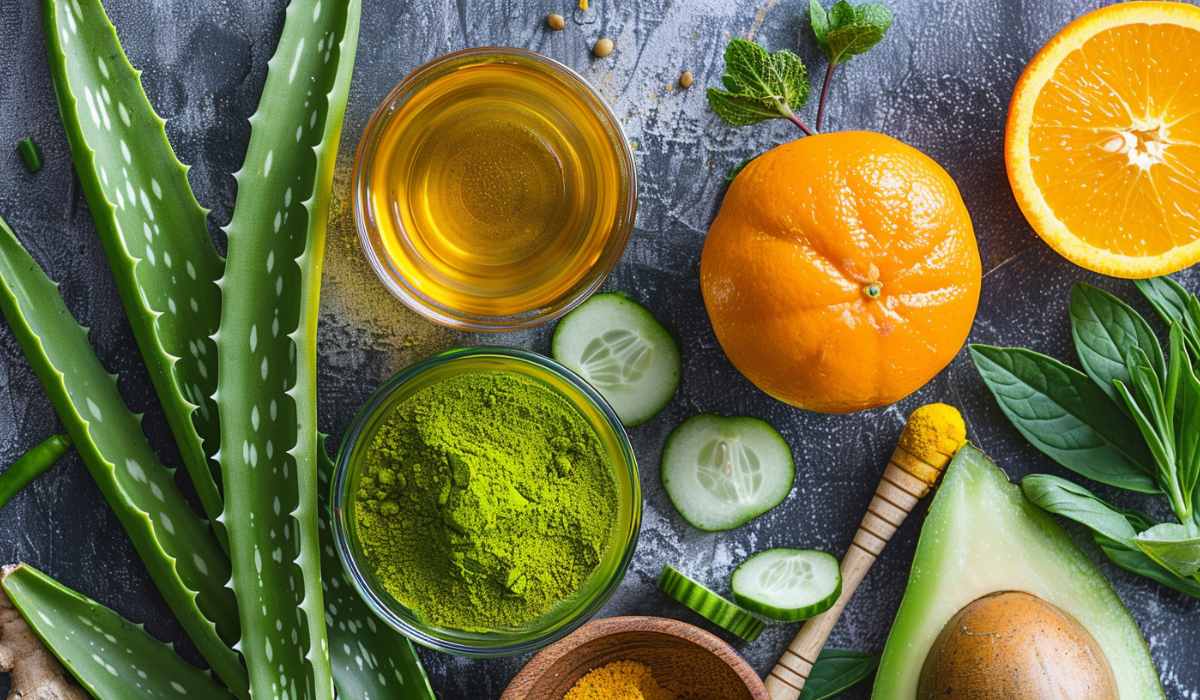My Top 10 Natural Skin Care Solutions for Hyperpigmentation
Today, I’m delighted to invite you on a special journey: discovering the natural ingredients that can (really) help with hyperpigmentation.
At the market where I sell my skincare, I get asked this question all the time. “How to get rid of my hyperpigmentation?”
The answer is not an easy one, since the factors causing hyperpigmentation are as varied as the solutions to address it.
From the sun’s relentless rays that darken our skin to hormonal changes that leave their mark, each cause of hyperpigmentation brings its own challenge (you can learn more about hyperpigmentation and the causes of it).
The real question is, “can I get rid of hyperpigmentation using ONLY natural ingredients?”
The answer is yes.
But you need to be patient AND consistent.
Natural ingredients can work wonders over time, gently fading dark spots and bringing your skin back to its natural glow.

I’m 55, live in a VERY HOT part of Spain where the sun shines (on my face) all day, and I don’t have one single dark spot left (I used to, before using my natural products).
The article below contains affiliate links at no extra cost to you.
What exactly is hyperpigmentation? What causes it?
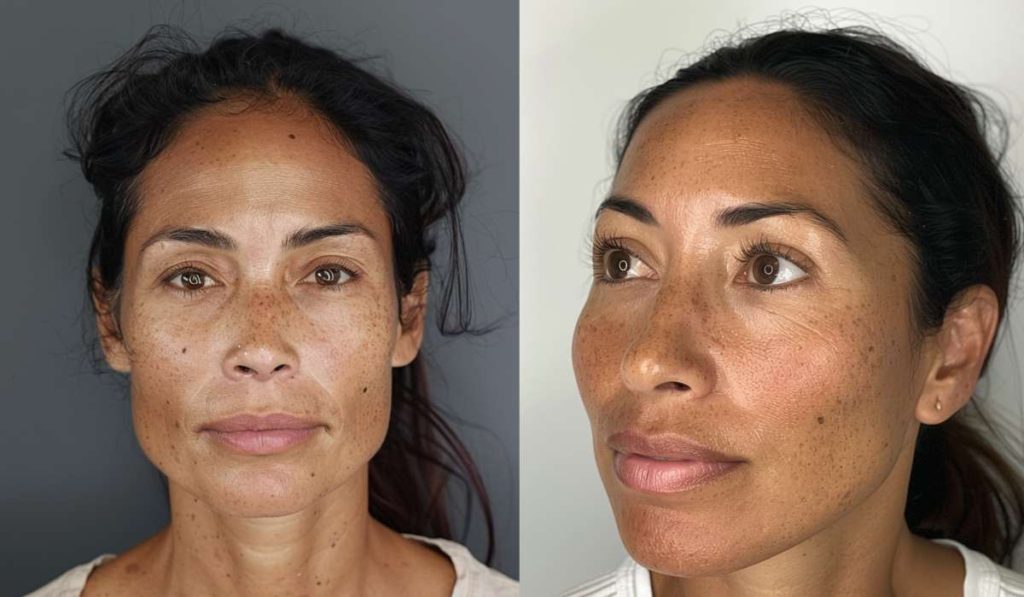
Hyperpigmentation is characterised by dark patches (or dark spots) on the skin. It occurs when excess melanin forms these marks, often due to sun exposure, hormonal changes, ageing, or injury.
- Too much sun’s UV rays (melanin production increases for skin protection, it makes sense).
- Hormonal changes (pregnancy, birth control, menopause – this type of hyperpigmentation is called “melasma”)
- Post-inflammatory hyperpigmentation (can occur after an injury or skin inflammation)
Many of my clients at the market where I sell my skincare ask me for a solution to fade or completely remove the dark marks. I always point them in the “natural” direction.
Can natural ingredients fade away dark spots?
Commercial products can be effective, since they’re made with strong ingredients specifically to quickly tackle hyperpigmentation.
But, they come at a cost: potential side effects, such as irritation, sensitivity, and compromising the skin’s natural barrier.
Unlike their commercial counterparts, natural ingredients offer a gentler, more harmonious approach to skincare. THEY DO WORK when it comes to reducing (and removing!) dark spots WITHOUT the harsh side effects.
In the guide below, I show you what these ingredients are. Each of them works by gently reducing melanin production.
My top 10 natural skin care solutions for hyperpigmentation
Exploring the powerful brightening effects of Vitamin C to the gentle care of Aloe Vera, we’ll look into how each ingredient helps lighten dark spots and even out skin tone.
- Azelaic acid: Though not exclusively natural, azelaic acid is derived from grains like barley, wheat, and rye and has been found effective in treating hyperpigmentation by inhibiting tyrosinase.
- Kojic acid: Produced by certain fungi, kojic acid is often used for its effective skin-lightening properties. It works by inhibiting the production of melanin, helping to lighten existing sunspots and prevent new ones from forming.
- Vitamin C: A powerful antioxidant, Vitamin C helps to lighten hyperpigmentation, even out skin tone, and enhance skin radiance. It can also inhibit melanin production, which can reduce the appearance of dark spots.
- Niacinamide (Vitamin B3): This vitamin works by inhibiting the transfer of melanin to skin cells, effectively reducing the appearance of dark spots and improving skin texture.
- Alpha-arbutin: A natural compound derived from bearberry, blueberry, and cranberry plants. It works by slowly releasing hydroquinone, which inhibits tyrosinase and reduces melanin production, thus fading dark spots.
- Licorice extract: Contains glabridin, which has been shown to inhibit tyrosinase, an enzyme that’s crucial in the production of melanin. Licorice extract can help diminish the appearance of dark spots and even out skin tone.
- Turmeric: Contains curcumin, which has anti-inflammatory, antimicrobial, and antioxidant properties. It can help reduce melanin production and is used to treat hyperpigmentation and even out skin tone.
- Mulberry leaf extract: Mulberries contain compounds that can inhibit tyrosinase activity, thus reducing melanin production. Mulberry leaf extract can help fade dark spots and improve skin tone.
- Green tea extract: Rich in antioxidants, particularly epigallocatechin gallate (EGCG), green tea extract can help reduce melanin production and fight off dark spots due to UV exposure and aging.
- Aloe vera: Known for its soothing properties, aloe vera also contains aloin, a natural depigmenting compound that can help lighten skin and reduce the appearance of hyperpigmentation.
1. Azelaic acid

- Best for: Melasma, post-inflammatory hyperpigmentation, acne-related dark spots.
- Why It Works: Reduces melanin production and has anti-inflammatory properties.
- Time to Work: Some improvement can be seen in 4-6 weeks, with significant results in 3-4 months.
- Where to Find: Available in creams, gels, and as part of skincare formulas. Prescription options are also available for higher concentrations.
- Application: Apply to affected areas once or twice daily, as directed by the product or a healthcare provider.
- Side Effects: May cause skin dryness, redness, and peeling in some individuals.
- Complements With: Often used with glycolic acid or retinoids for enhanced skin renewal, but caution is advised to avoid irritation.
- Precautions: Avoid if you have very sensitive skin or eczema, and use sun protection, as it can make the skin more sensitive to the sun.
2. Kojic Acid
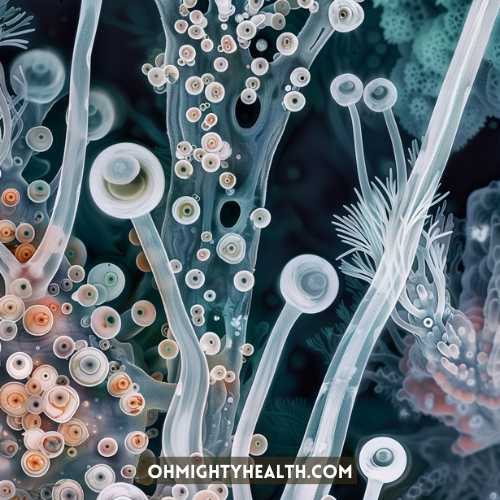
- Best for: Sun spots, age spots, and melasma.
- Why It Works: Inhibits the production of melanin by interfering with the activity of tyrosinase.
- Time to Work: Noticeable results can often be seen within 4-8 weeks of consistent use.
- Where to Find: Found in soaps, creams, and serums, often combined with other brightening ingredients.
- Application: Apply to affected areas once or twice daily, following the specific product’s instructions.
- Side Effects: Can cause sensitivity or irritation, especially in those with sensitive skin.
- Complements With: Vitamin C for enhanced brightening effects. However, monitor skin reaction to avoid irritation.
- Precautions: Conduct a patch test before full use to ensure no allergic reaction. Use sunscreen, as it may increase sun sensitivity.
3. Vitamin C

- Best for: Age spots, sun spots, overall skin brightening.
- Why It Works: High in antioxidants, inhibits melanin production.
- Time to Work: Visible results in 3-4 weeks with daily use.
- Where to Find: Available in serums, creams, and as a pure powder for DIY mixtures.
- Application: Apply topically once or twice daily, preferably in the morning under sunscreen.
- Side Effects: Rare, but may include mild irritation or sensitivity in some people.
- Complements With: Works well with Vitamin E and ferulic acid for enhanced protection and efficacy.
- Precautions: Always use SPF during the day as it makes skin more sensitive to the sun.
4. Niacinamide (Vitamin B3)
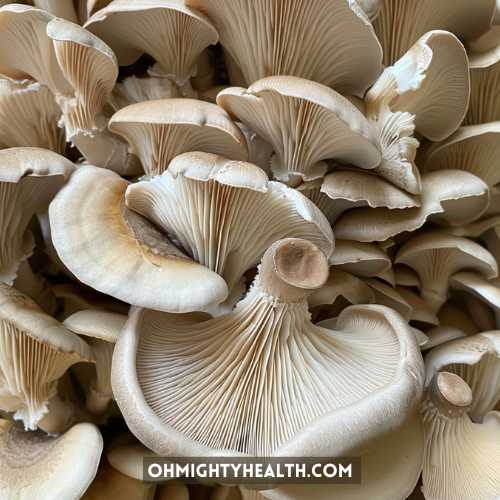
- Best for: Overall skin tone improvement, reducing redness, and lightening post-inflammatory hyperpigmentation.
- Why It Works: Inhibits melanin transfer to the skin’s surface and boosts skin barrier function.
- Time to Work: Noticeable results are often seen within 4-8 weeks of regular use.
- Where to Find: Widely available in serums, moisturisers, and combined formulas with other active ingredients.
- Application: Apply topically to clean skin, once or twice daily. Can be layered under sunscreen or makeup.
- Side Effects: Very well tolerated, but some may experience mild irritation at high concentrations.
- Complements With: Works well alongside most skincare ingredients, including retinol, for enhanced skin benefits without increasing irritation.
- Precautions: Start with a lower concentration if you have sensitive skin and always use in conjunction with sunscreen during the day.
5. Alpha-Arbutin
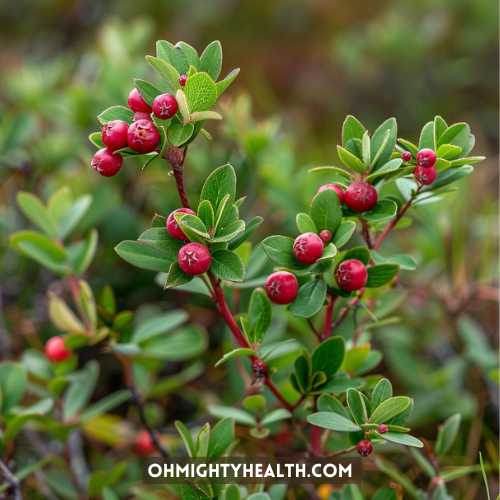
- Best for: Reducing the look of sun spots, age spots, and melasma.
- Why It Works: Slowly releases hydroquinone, which inhibits melanin production, lightening dark spots.
- Time to Work: Initial improvement in 2-3 weeks, with significant results in 3-6 months.
- Where to Find: Found in serums, creams, and as part of brightening skincare formulas.
- Application: Apply to clean skin twice daily, morning and night, for best results.
- Side Effects: Generally well tolerated, but can cause mild irritation or sensitivity in some individuals.
- Complements With: Enhances effectiveness when used with Vitamin C or niacinamide.
- Precautions: Use with sunscreen to protect the skin, as it can become more sensitive to UV damage.
6. Licorice extract

- Best for: Melasma, sun spots, and reducing redness in post-inflammatory hyperpigmentation.
- Why It Works: Contains glabridin, which inhibits tyrosinase to prevent melanin production, and liquiritin, which disperses existing melanin.
- Time to Work: Visible results can start showing within 4-8 weeks of consistent use.
- Where to Find: Available in serums, creams, and as a component in multi-ingredient skincare products.
- Application: Apply topically to affected areas once or twice daily, as part of your skincare routine.
- Side Effects: Rare, but can include mild irritation in sensitive individuals.
- Complements With: Often combined with other brightening agents like Vitamin C for enhanced effects.
- Precautions: Perform a patch test if you have sensitive skin and use alongside sunscreen to prevent further sun-induced hyperpigmentation.
7. Turmeric
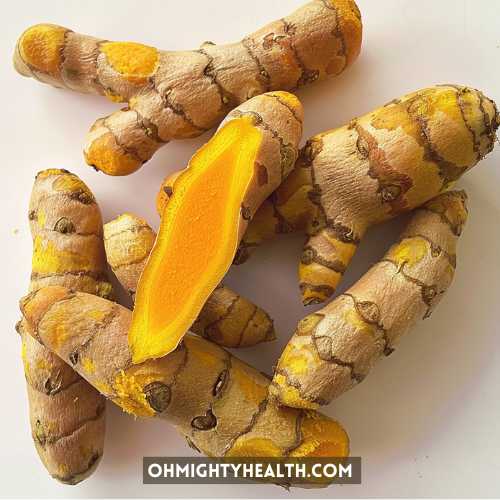
- Best for: Evening out skin tone and reducing the appearance of post-inflammatory hyperpigmentation.
- Why It Works: Contains curcumin, which has anti-inflammatory, antimicrobial, and antioxidant properties, helping to reduce melanin production.
- Time to Work: Some users report seeing initial improvements within a few weeks, with more significant changes in 2-3 months of regular use.
- Where to Find: Available as a raw ingredient for DIY masks, in serums, and in creams formulated for skin brightening.
- Application: When using raw turmeric, create a paste with water or agave syrup and apply as a mask once or twice a week. For commercial products, follow the specific instructions for daily use.
- Side Effects: Turmeric can stain the skin and fabrics yellow, especially in its raw form. Sensitive individuals may experience irritation.
- Complements With: Works well with ingredients like agave or yoghurt in DIY masks for added soothing and hydrating benefits.
- Precautions: Test on a small area first to check for any adverse reaction, especially if you have sensitive skin. Always use sunscreen as turmeric can make your skin more sensitive to the sun.
8. Mulberry Leaf Extract

- Best for: Age spots, sun spots, and brightening overall skin tone.
- Why It Works: Contains compounds that inhibit tyrosinase, reducing melanin production and lightening dark spots.
- Time to Work: Expect to see initial improvements in 4-8 weeks with consistent use.
- Where to Find: Found in serums, creams, and as part of formulas designed for brightening and evening out skin tone.
- Application: Apply topically to the affected areas once or twice daily, ideally as part of your morning and evening skincare routines.
- Side Effects: Generally well tolerated, but some individuals may experience mild sensitivity.
- Complements With: Works well in combination with antioxidants like Vitamin C for a boosted brightening effect.
- Precautions: Always use with sunscreen during the day to protect the skin from further UV damage and enhance the effectiveness of the treatment.
YOU CAN BUY MULBERRY LEAF EXTRACT HERE.
9. Green tea extract

- Best for: Lightening sun-induced hyperpigmentation and improving overall skin health.
- Why It Works: Rich in antioxidants, particularly epigallocatechin gallate (EGCG), which reduces melanin production and has anti-inflammatory benefits.
- Time to Work: Visible changes can be noticed in 6-12 weeks of regular use.
- Where to Find: Available in serums, creams, and lotions, often highlighted in products aimed at soothing and protecting the skin.
- Application: Apply topically to the skin once or twice daily. Can be used in both morning and evening skincare routines.
- Side Effects: Well tolerated by most skin types, with minimal risk of irritation.
- Complements With: Enhances effects when combined with other antioxidants or soothing agents like aloe vera.
- Precautions: While green tea extract is gentle, always patch test first, and pair with sunscreen for daytime protection.
10. Aloe vera

- Best for: Mild sun-induced hyperpigmentation and soothing irritated skin.
- Why It Works: Contains aloin, a natural depigmenting compound that helps lighten skin and reduce the appearance of dark spots.
- Time to Work: Improvements can be seen in 8-12 weeks with daily application.
- Where to Find: Available in its pure gel form from the aloe plant, as well as in various skincare products like creams, gels, and lotions.
- Application: Apply the gel directly to the affected areas once or twice daily, especially after sun exposure.
- Side Effects: Rare, but some people may experience allergic reactions or skin irritation, especially with fresh aloe gel.
- Complements With: Works well with hydrating ingredients like hyaluronic acid to boost skin moisture along with lightening hyperpigmentation.
- Precautions: Conduct a patch test if using fresh aloe gel for the first time and always use sunscreen during the day to protect the skin.
When using natural ingredients for skin care, especially for treating hyperpigmentation, it’s essential to be patient, as results can take time to appear. Additionally, always perform a patch test before applying new products to your entire face, and consider consulting with a dermatologist to ensure the chosen ingredients are suitable for your skin type and condition.
Smart ingredient combinations
Boost your brightening power
- Vitamin C + Ferulic Acid: Enhances the stability and effectiveness of Vitamin C, making it a powerhouse for fading dark spots. Mix a few drops of each in your morning routine.
- Aloe Vera + Turmeric: For a soothing, anti-inflammatory effect with added brightening benefits. Mix a tablespoon of aloe gel with a teaspoon of turmeric powder for a gentle face mask. Apply the mixture to clean skin, leave it on for 15-20 minutes, and then rinse off with lukewarm water. Use this mask 1-2 times a week for best results. Remember to apply sunscreen if you’re going out, as turmeric can make your skin more sensitive to the sun.
Ingredients to pair wisely
- Niacinamide + Alpha-Arbutin: Both are gentle on the skin and work to reduce melanin production, making them a safe bet for daily use together in your routine.
Mix with caution
- Avoid High-Dose Vitamin C with Niacinamide: High concentrations can react and diminish each other’s effects. Use them at different times of the day to avoid interaction.
Safety First
- Always do a patch test when trying a new combination, especially if you have sensitive skin.
- Start with lower concentrations to see how your skin reacts.
Remember, while experimenting at home can be rewarding, consulting with a skincare professional before trying new ingredient mixes is always a good idea, especially for persistent or severe hyperpigmentation.
Daily skincare routine tips
Creating an effective skincare routine with natural ingredients means knowing not just what to use, but when and how to use them for maximum benefit.
Here’s a simplified guide to help you weave these powerful ingredients into your daily skincare regimen.
Morning routine
- Start with Vitamin C: Kick off your day with a Vitamin C serum. It’s not only a potent brightener but also offers antioxidant protection against environmental stressors. Apply after cleansing, before moisturizer.
- Layer with Sunscreen: Always follow up with a broad-spectrum SPF. Vitamin C enhances its effectiveness, providing an extra layer of protection against hyperpigmentation caused by sun exposure.
Evening routine
- Gentle Cleansing: Begin with a mild cleanser to remove impurities without stripping the skin’s natural oils.
- Apply Targeted Treatments: Evening is the best time for ingredients like Azelaic Acid, Niacinamide, or Alpha-Arbutin, which work on hyperpigmentation while you sleep. They’re less likely to react with sunlight, allowing them to work uninterrupted.
- Moisturize: Finish with a hydrating moisturizer. If you’re using Aloe Vera, it can be a soothing final step, especially if you’ve been out in the sun.
Twice a week
- Exfoliate: Use a gentle exfoliant to remove dead skin cells and enhance ingredient absorption. Avoid over-exfoliation to prevent irritation.
- Turmeric and Aloe Mask: Incorporate the soothing mask of turmeric and aloe vera for its anti-inflammatory and brightening benefits.
Layering products
- Thin to Thick: Apply products from thinnest to thickest texture. For example, serums before creams.
- Wait in Between: Give each product time to absorb before applying the next layer, usually a minute or two.
General tips
- Patch Test: Always patch test new products or combinations, especially if you have sensitive skin.
- Consistency Is Key: Results take time and regular application. Be patient and consistent with your routine.
- Adjust as Needed: Listen to your skin. If you experience irritation, scale back on active ingredients or frequency of use.
This guide is a starting point. Tailor your routine to what best suits your skin’s needs and responses, and don’t hesitate to consult a dermatologist for personalised advice, especially for severe hyperpigmentation issues.
DIY natural ingredient recipes for hyperpigmentation
The below are simple, effective DIY recipes designed to tackle your hyperpigmentation.
1. Vitamin C serum
- Ingredients: 1 teaspoon Vitamin C powder (L-ascorbic acid), 1 teaspoon distilled water, 1 teaspoon glycerin, a few drops of Vitamin E oil (optional for stability and added benefits).
- Instructions: Dissolve the Vitamin C powder in distilled water completely. Add glycerin and Vitamin E oil, mixing well. Use a few drops on clean skin every morning, followed by sunscreen. Store in a dark, airtight container. Place in the refrigerator to extend shelf life and slow down oxidation rate. Use within 1-2 weeks.
Turmeric and aloe brightening mask
- Ingredients: 1 tablespoon aloe vera gel, 1 teaspoon turmeric powder, 1 teaspoon agave syrup (optional, for added moisture and to enhance the mask’s soothing effects).
- Instructions: Mix all ingredients to form a smooth paste. Apply to clean, dry skin, avoiding the eye area. Leave on for 15-20 minutes, then rinse off with lukewarm water. Use once or twice a week for best results.
Niacinamide brightening toner
- Ingredients: 1 cup distilled water, 1 tablespoon niacinamide powder, 1 tablespoon rose water (for additional soothing and hydrating effects).
- Instructions: Dissolve the niacinamide powder in distilled water. Add rose water and mix well. Store in a clean, airtight bottle. Apply with a cotton pad to cleansed skin nightly.
Liquorice root spot treatment
- Ingredients: ½ cup distilled water, 1 tablespoon liquorice root extract.
- Instructions: Mix the licorice root extract with distilled water until well combined. Apply directly to dark spots using a cotton swab or pad. Use nightly for targeted treatment.
Green tea and agave soothing mask
- Ingredients: 1 tablespoon green tea leaves (or 1 green tea bag), hot water, 1 tablespoon agave syrup.
- Instructions: Steep green tea leaves in hot water for 5 minutes. Strain and allow the tea to cool. Mix in agave syrup until you have a thick paste. Apply to the face and leave on for 20 minutes before rinsing off. Use weekly for soothing and brightening effects.
Conclusion
Remember, the journey to even-toned, radiant skin is a personal one, filled with discoveries and small victories along the way.
Embrace these natural remedies with an open heart and mind, and allow yourself the grace to see the transformation unfold at its own pace.
After all, the essence of natural beauty is not just in achieving flawless skin but in nurturing our bodies with the love and respect they deserve.

